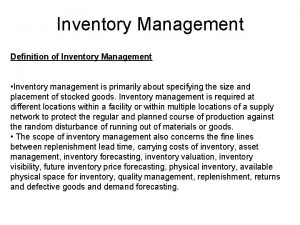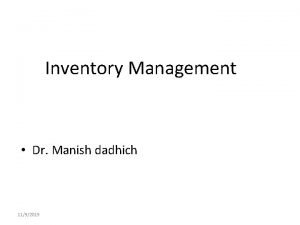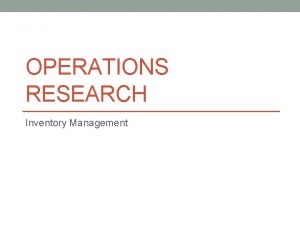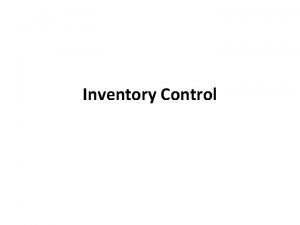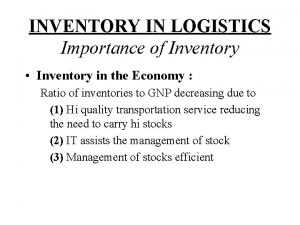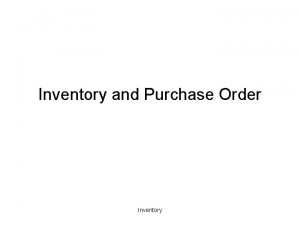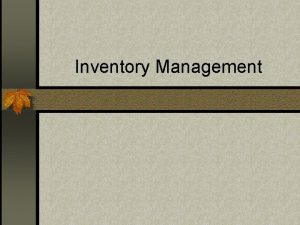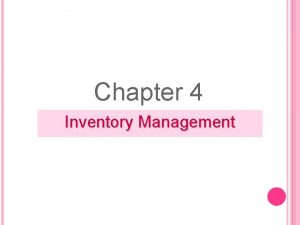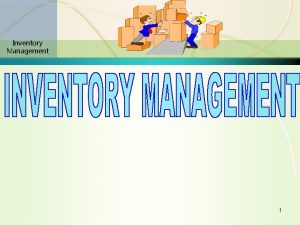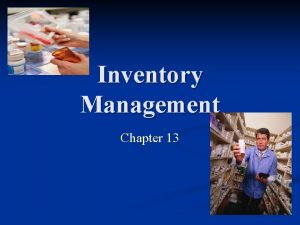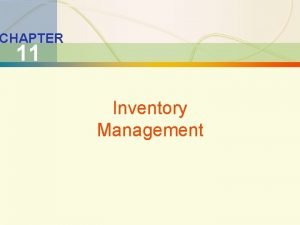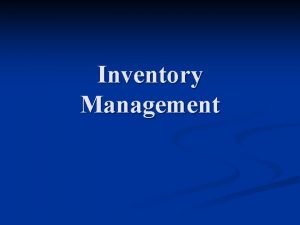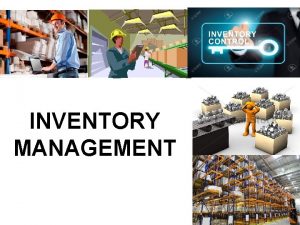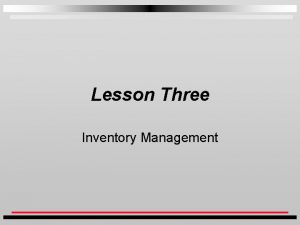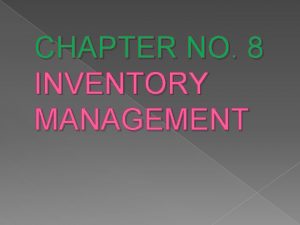5 INVENTORY MANAGEMENT Inventory definition Inventory are the























- Slides: 23

5 INVENTORY MANAGEMENT

Inventory definition • Inventory are the items used to support: – production (raw materials and work-in-process items), – supporting activities (maintenance, repair and operating supplies) and – customer service (finished goods and spare parts) (APICS dictionary) • Inventory is the stock of any item or resource used in an organization

Why inventory occure ? Variance between the rate of input (rate of supply) and the rate of output (rate of demand) Flow Model of Inventory Rate of input (supply rate) Cyclic inventory Noncyclic inventory Rate of output (demand rate)

Types of Inventory Raw materials inventory Work-in-process (WIP) inventory Finished products inventory

Types of Inventory • Raw materials inventory: The purchased items that are transformed into components or products. • Components inventory: Parts or subassemblies used in building the final product. • Work-in-process (WIP) inventory: Any item that is in some stage of completion in the manufacturing process • Finished goods inventory: Completed products that will be delivered to customers. • Maintenance, repair, and operational (MRO) inventory: Inventories of some items (such as maintenance supplies, spare parts, lubricants, cleaning compounds, and office supplies) are used to support general operations and maintenance • Distribution inventory: Finished goods and spare parts that are at various points in the distribution system.

Types of Inventory Division of inventory based on the type of demand • Independent demand inventory – demand for item is independent on demand of others items (the source of demand is usually from an external customer). Items of independent demand are the finished products • Dependent demand inventory – demand for item is dependent directly on demand of another item. Items of dependent demand are the components and raw materials Stool Leg x (4) Independent demand Seat (1) Dependent demand Demand forcast - 100 stools, independent demand Calculation – 400 legs, dependent demand

Inventory functions • To decouple or separate various parts of the production process • To provide a stock of goods to meet anticipated customer demand provide a “selection” of goods • To balance the seasonal fluctuations in demand • To take advantage of quantity discounts • To hedge against inflation and price changes • To protect against delivery variation due to weather, supplier shortages, quality problems. Safety stocks – reduce the risk of shortages

Inventory Usage over Time Stock consumption Stock replenishement Quantity Average stock CYCLIC STOCK Safety stock Excess stock NON-CYCLIC STOCK Time

Inventory in the manufacturing company Supply stage S U P P L I E R S Supplies PURCHASED STOCKS t raw materials t components Production stage Parts production Products assembly PROCESSED STOCKS (unfinished production) t work in progress Distribution stage Distribution STOCKS FOR SALE t finished products t spare parts C U S T O M E R S

Inventory costs FIXED COSTS INDEPENDENT on the order quantity u Purchasing cost/unit, production cost/unit u Costs of stock facilities u Staff costs VARIABLE COSTS DEPENDENT on the order quantity u Holding costs u Ordering costs/Setup or production change costs u Shortage costs u Excess costs

Inventory costs ORDERING COST/ PURCHASING COST • • • SETUP COST Supplies Forms Order processing Clerical support Etc. • • Clean-up costs Re-tooling costs Adjustment costs Etc. HOLDING COST • • • Warehousing Obsolescence Insurance Interest Damage Etc. SHORTAGE COST Stockout Cost • Backorders (customer order for the product • must wait until the stock is replenished) backorders service cost, lower service cost Lost sale (customer order is cancelled) profit lost cost, lower service cost EXCESS COST Inventory Risk Cost • excess is holding in the next periods cost of prolonged holding stock, cost of price reduction • excess is not holding in the next periods (lost sale) liquidation (clearing) stock cost

Holding (Carrying) Costs (calculation) Category • • • Warehousing Obsolescence Insurance Extra staffing Interest Damage Total holding cost (variable) H = % * price/unit % of Inventory Value 3% 6% 3% 2% 5% 4% 23% of Inventory Value

Goal of inventory management To find a balance between customer service level and cost of shortage Availability level Level of customer service Safety stock level Risk of shortage 100 % There is a trade off between carrying stock to satisfy demand (customer service) and the costs resulting from stock out (cost of shortage). Example: Availability level (customer service level) - 90% Probability of shortage Availability level (customer service level) Probability of shortage Safety stock must be increased -10% - 95% - 5%

Inventory management decisions Purchased stock Manufactured stock HOW MUCH TO ORDER ? HOW MUCH TO ORDER? Determine the order quantity (purchasing batch/lot) Determine the production order quantity (production batch/lot) WHEN TO ORDER ? Determine the purchased order loanched time Determine the production order loanched time

INVENTORY MANAGEMENT SYSTEM Inventory management system is the set of policies and controls that monitor levels of inventory and determine what stock level should be maintained, when stock should be replenished, and how large orders should be.

INVENTORY MANAGEMENT SYSTEMS INVENTORY MANAGEMENT (CONTROL) SYSTEMS INDEPENDENT DEMAND INVENTORY CONTROLSYSTEMS PERIODIC REVIEW SYSTEMS CONTINUOUS REVIEW SYSTEMS FIXED ORDER PERIOD SYSTEMS FIXED ORDER QUANTITY SYSTEMS DEPENDENT DEMAND INVENTORY CONTROL SYSTEMS MATERIAL REQUIREMENTS PLANNING SYSTEM (MRP) Economic Order Quantity Model Economic Production Quantity Model Back Order Inventory Model Quantity Discounts Model

Fixed Order Quantity Systems ASSUMPTIONS u Order quantity is fixed (constant) u Order cycle – variable u Continuous inventory level control How much to order? (Order Quantity Models) FIXED ORDER QUANTITY - FOQ Possible options 1. Order quantity is arbitrary define (for example Q = 1000 units) 2. Order quantity is define using Economic Order Quantity Model - EOQ

Economic Order Quantity Model – EOQ ASSUMPTIONS u Demand is known and constant u Lead time (delivery time) is known and constant u Stock replenishment is immediate Q - order quantity S - maximal stock Sav - average stock R - reorder point T - order cycle Cz - Stock cycle LT - lead time (delivery time) WD- number of working days per year

Economic Order Quantity calculation D - annual demand Annul cost HC- annual holding cost H - holding cost per unit per year SC - total order cost per year S - cost per order Total Cost Holding Cost Cmin Setup Cost Q* Objective : Total cost minimalization TC – total cost Cmin – minimal total cost Q - order quantity EOQ/Q*- economic order quantity Q Economic Order Quantity

EOQ Model - example DATA Number of orders per year D S H WD Annual holding cost = 1200 units/year = 100 $/order = 6 $/unit. /year = 240 working days /year Economic Order Quantity Total order cost per year Maximal stock Total inventory cost Average stock Order cycle

When to order? - Reorder Point model Reorder Point (R) - Stock level which inform about the necessity of placing an order to replenish inventory Where: Q S SS Sav R d LT - order quantity - maximal stock - safety stock - average stock - reorder point - demand rate - lead time (delivery time)

Fixed Order Period System Assumptions u Quantity ordered - varies u Fixed order cycle u Periodic inventory monitoring Reorder point T Q S s SS d LT - order cycle (order period) - order quantity - desired level of inventory - point at what order is placed - safety stock - demand rate - lead time (delivery time) ORDER QUANTITY?

FOQ and FOP - comparison FIXED ORDERQUANTITY SYSTEM FOQ Filling your tank with 40 liters when the level reach 1/10 full FIXED ORDERPERIOD SYSTEM FOQ Filling your tank every Saturday
 Antigentest åre
Antigentest åre Chapter 12 inventory management
Chapter 12 inventory management Hình ảnh bộ gõ cơ thể búng tay
Hình ảnh bộ gõ cơ thể búng tay Bổ thể
Bổ thể Tỉ lệ cơ thể trẻ em
Tỉ lệ cơ thể trẻ em Gấu đi như thế nào
Gấu đi như thế nào Tư thế worm breton là gì
Tư thế worm breton là gì Chúa yêu trần thế
Chúa yêu trần thế Các môn thể thao bắt đầu bằng tiếng chạy
Các môn thể thao bắt đầu bằng tiếng chạy Thế nào là hệ số cao nhất
Thế nào là hệ số cao nhất Các châu lục và đại dương trên thế giới
Các châu lục và đại dương trên thế giới Công thức tính độ biến thiên đông lượng
Công thức tính độ biến thiên đông lượng Trời xanh đây là của chúng ta thể thơ
Trời xanh đây là của chúng ta thể thơ Cách giải mật thư tọa độ
Cách giải mật thư tọa độ Làm thế nào để 102-1=99
Làm thế nào để 102-1=99 Phản ứng thế ankan
Phản ứng thế ankan Các châu lục và đại dương trên thế giới
Các châu lục và đại dương trên thế giới Thể thơ truyền thống
Thể thơ truyền thống Quá trình desamine hóa có thể tạo ra
Quá trình desamine hóa có thể tạo ra Một số thể thơ truyền thống
Một số thể thơ truyền thống Bàn tay mà dây bẩn
Bàn tay mà dây bẩn Vẽ hình chiếu vuông góc của vật thể sau
Vẽ hình chiếu vuông góc của vật thể sau Biện pháp chống mỏi cơ
Biện pháp chống mỏi cơ























